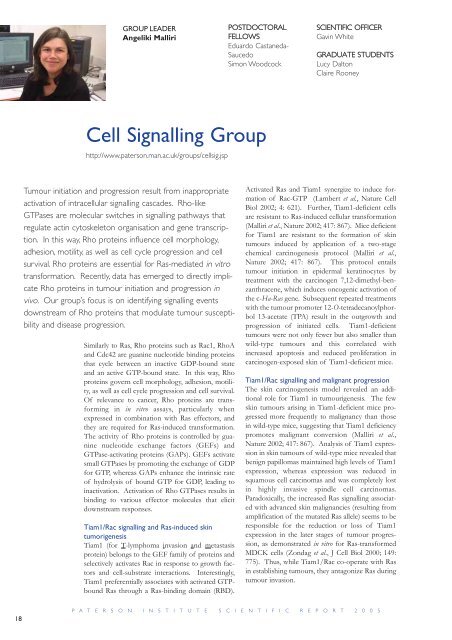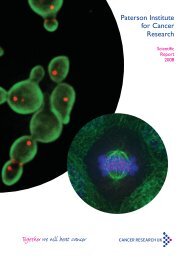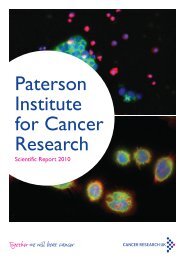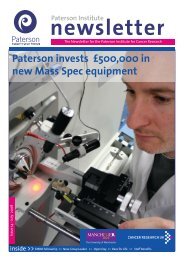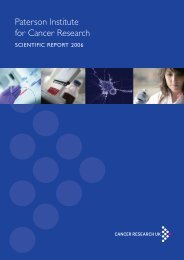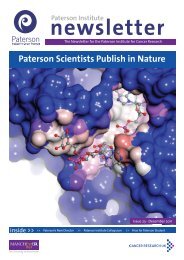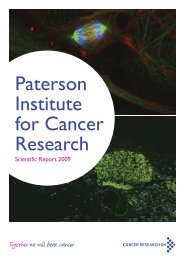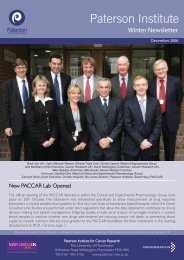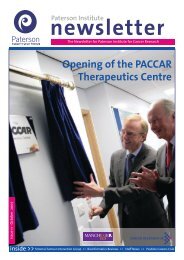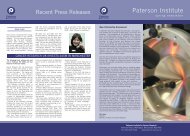Paterson Institute for Cancer Research SCIENTIFIC REPORT 2005
Paterson Institute for Cancer Research SCIENTIFIC REPORT 2005
Paterson Institute for Cancer Research SCIENTIFIC REPORT 2005
You also want an ePaper? Increase the reach of your titles
YUMPU automatically turns print PDFs into web optimized ePapers that Google loves.
18<br />
GROUP LEADER<br />
Angeliki Malliri<br />
Cell Signalling Group<br />
http://www.paterson.man.ac.uk/groups/cellsig.jsp<br />
Tumour initiation and progression result from inappropriate<br />
activation of intracellular signalling cascades. Rho-like<br />
GTPases are molecular switches in signalling pathways that<br />
regulate actin cytoskeleton organisation and gene transcription.<br />
In this way, Rho proteins influence cell morphology,<br />
adhesion, motility, as well as cell cycle progression and cell<br />
survival. Rho proteins are essential <strong>for</strong> Ras-mediated in vitro<br />
trans<strong>for</strong>mation. Recently, data has emerged to directly implicate<br />
Rho proteins in tumour initiation and progression in<br />
vivo. Our group’s focus is on identifying signalling events<br />
downstream of Rho proteins that modulate tumour susceptibility<br />
and disease progression.<br />
Similarly to Ras, Rho proteins such as Rac1, RhoA<br />
and Cdc42 are guanine nucleotide binding proteins<br />
that cycle between an inactive GDP-bound state<br />
and an active GTP-bound state. In this way, Rho<br />
proteins govern cell morphology, adhesion, motility,<br />
as well as cell cycle progression and cell survival.<br />
Of relevance to cancer, Rho proteins are trans<strong>for</strong>ming<br />
in in vitro assays, particularly when<br />
expressed in combination with Ras effectors, and<br />
they are required <strong>for</strong> Ras-induced trans<strong>for</strong>mation.<br />
The activity of Rho proteins is controlled by guanine<br />
nucleotide exchange factors (GEFs) and<br />
GTPase-activating proteins (GAPs). GEFs activate<br />
small GTPases by promoting the exchange of GDP<br />
<strong>for</strong> GTP, whereas GAPs enhance the intrinsic rate<br />
of hydrolysis of bound GTP <strong>for</strong> GDP, leading to<br />
inactivation. Activation of Rho GTPases results in<br />
binding to various effector molecules that elicit<br />
downstream responses.<br />
Tiam1/Rac signalling and Ras-induced skin<br />
tumorigenesis<br />
Tiam1 (<strong>for</strong> T-lymphoma invasion and metastasis<br />
protein) belongs to the GEF family of proteins and<br />
selectively activates Rac in response to growth factors<br />
and cell-substrate interactions. Interestingly,<br />
Tiam1 preferentially associates with activated GTPbound<br />
Ras through a Ras-binding domain (RBD).<br />
POSTDOCTORAL<br />
FELLOWS<br />
Eduardo Castaneda-<br />
Saucedo<br />
Simon Woodcock<br />
<strong>SCIENTIFIC</strong> OFFICER<br />
Gavin White<br />
GRADUATE STUDENTS<br />
Lucy Dalton<br />
Claire Rooney<br />
Activated Ras and Tiam1 synergize to induce <strong>for</strong>mation<br />
of Rac-GTP (Lambert et al., Nature Cell<br />
Biol 2002; 4: 621). Further, Tiam1-deficient cells<br />
are resistant to Ras-induced cellular trans<strong>for</strong>mation<br />
(Malliri et al., Nature 2002; 417: 867). Mice deficient<br />
<strong>for</strong> Tiam1 are resistant to the <strong>for</strong>mation of skin<br />
tumours induced by application of a two-stage<br />
chemical carcinogenesis protocol (Malliri et al.,<br />
Nature 2002; 417: 867). This protocol entails<br />
tumour initiation in epidermal keratinocytes by<br />
treatment with the carcinogen 7,12-dimethyl-benzanthracene,<br />
which induces oncogenic activation of<br />
the c-Ha-Ras gene. Subsequent repeated treatments<br />
with the tumour promoter 12-O-tetradecanoylphorbol<br />
13-acetate (TPA) result in the outgrowth and<br />
progression of initiated cells. Tiam1-deficient<br />
tumours were not only fewer but also smaller than<br />
wild-type tumours and this correlated with<br />
increased apoptosis and reduced proliferation in<br />
carcinogen-exposed skin of Tiam1-deficient mice.<br />
Tiam1/Rac signalling and malignant progression<br />
The skin carcinogenesis model revealed an additional<br />
role <strong>for</strong> Tiam1 in tumourigenesis. The few<br />
skin tumours arising in Tiam1-deficient mice progressed<br />
more frequently to malignancy than those<br />
in wild-type mice, suggesting that Tiam1 deficiency<br />
promotes malignant conversion (Malliri et al.,<br />
Nature 2002; 417: 867). Analysis of Tiam1 expression<br />
in skin tumours of wild-type mice revealed that<br />
benign papillomas maintained high levels of Tiam1<br />
expression, whereas expression was reduced in<br />
squamous cell carcinomas and was completely lost<br />
in highly invasive spindle cell carcinomas.<br />
Paradoxically, the increased Ras signalling associated<br />
with advanced skin malignancies (resulting from<br />
amplification of the mutated Ras allele) seems to be<br />
responsible <strong>for</strong> the reduction or loss of Tiam1<br />
expression in the later stages of tumour progression,<br />
as demonstrated in vitro <strong>for</strong> Ras-trans<strong>for</strong>med<br />
MDCK cells (Zondag et al., J Cell Biol 2000; 149:<br />
775). Thus, while Tiam1/Rac co-operate with Ras<br />
in establishing tumours, they antagonize Ras during<br />
tumour invasion.<br />
P A T E R S O N I N S T I T U T E S C I E N T I F I C R E P O R T 2 0 0 5


